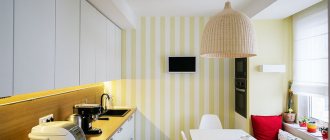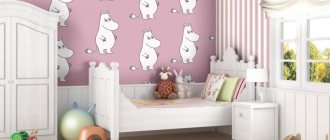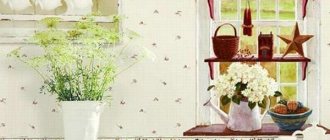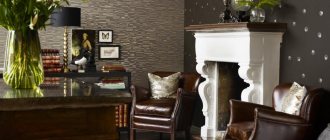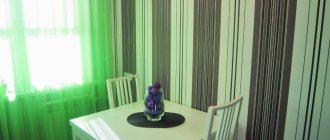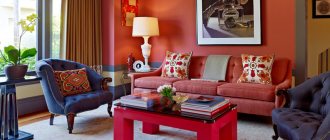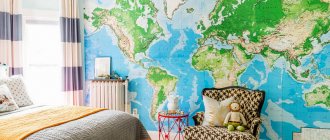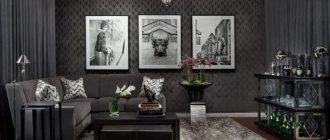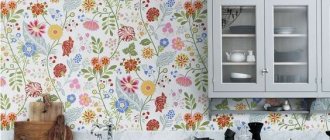Wallpaper selection
The most important thing: do not buy cheap wallpaper with designs and patterns. This is the worst thing you can do - the print quality on them is always terrible and it shows. If your budget is very limited, take plain wallpaper without patterns or patterns, they are quite normal. Just compare expensive and cheap wallpapers, and if this is visible even in the photo, imagine what it looks like in real life.
In this material we will talk about wallpaper for modern styles.
When choosing wallpaper, first of all you should pay attention to its surface - smooth or textured. In 2022, the variety of wallpapers, both in appearance and price, is simply enormous. But we will only talk about options up to $20/meter, because... There’s simply no point in paying more for wallpaper, because for that money you could already take a closer look at decorative plaster:
Wallpaper is objectively worse than decorative plaster and it cannot compete in the same niche. Therefore, we must understand why we choose wallpaper, and there are 2 reasons:
- This is the most budget-friendly finishing option. Wallpaper is inexpensive, gluing it is simple and cheap, and wallpaper does not require perfect preparation of the walls.
- The right patterns, designs, complex color schemes can only be realized this way (that’s why wallpaper is used even in the kitchen).
Here are a few photo examples where it would be impossible to achieve such an effect with anything other than wallpaper:
Hence the conclusion: it makes sense to choose plain wallpaper and wallpaper with interesting geometric and color patterns. It is about their combinations in the interior that we will talk. We repeat, we are talking only about modern styles, there is freedom in the classics for wallpaper, read about classic wallpaper in the material about the bedroom.
Materials
When combining wallpaper, you can experiment not only with colors, but also with different materials. There are matte, glossy, velvety wallpapers.
If you use coatings from different materials, but in the same color scheme, you can create a wonderful interior design.
Among the most popular materials are:
- Paper. A budget option is smooth single-layer wallpaper, but it is very difficult to work with. When water gets on the paper, they can tear easily. This is not very convenient when combining different parts. Due to the thin material, all defects will be visible on the wall.
The most suitable option is multi-layer duplex or triplex wallpaper. Their cost is slightly higher than the price of single-layer ones, but they also remain affordable for the average buyer. Such coatings hide minor imperfections on the walls. Their only drawback is that they quickly fade in the sun and tear easily.
- Vinyl. These wallpapers are made of paper or non-woven backing. Thanks to a variety of vinyl application techniques, the end result is many interesting models. Silk-screen wallpaper or heavy vinyl coverings are ideal for sleeping areas.
If the walls in the bedroom are smooth, then you can glue silk-screen materials. They look very solemn. A slight shine will be noticeable even in the dark; it resembles the shine of natural silk fabrics.
A significant drawback of such wallpaper is the heavy air in the room. Due to the vinyl waterproof film, the walls practically do not breathe. However, the problem can be completely resolved if you regularly ventilate the room or install ventilation in it.
- Non-woven. This wallpaper is made from non-woven material made from cellulose and chemical fibers. Vinyl or other decorative coating is applied to the non-woven base.
Non-woven fabrics are very durable, elastic and convenient for pasting walls. The technology is as simple as possible. A special glue is applied to dry wallpaper that does not corrode the surface. After this, the canvases are easily fixed on a vertical plane.
Due to the high density of the material, they look great even on uneven walls.
Such models are wide meter rolls. For large rooms this is very convenient; fewer joints are formed. It will be more difficult with small rooms. To avoid problems with joining the drawing, it is better to call a specialist who will minimize the likelihood of defects during the work.
Another disadvantage of non-woven wallpaper is its high price. However, it fully justifies itself due to the complex production technology and expensive fibers in the composition. By paying once, the apartment owner will not have to worry about the condition of the walls for many years.
- Textile. Wallpapers of this type are not available to everyone. They are often classified as luxury. They are made from a non-woven base and natural fabrics: jute, linen, cotton, velor or silk.
Hard fibers from flax and jute are embodied in fabrics that resemble matting. Fleecy wallpaper is made of velor or felt. Woven fabrics are produced in the form of very wide rolls, using which you can cover one entire wall in one go. This is very convenient because you don’t have to join different edges.
When combining, choose textile wallpaper from the same material, but in different colors. For example, the silky base is presented in a wide spectral range. However, the combination of different parts will not be carried out on one wall, but throughout the entire space of the room.
Textile fabrics have two significant disadvantages - high cost and problematic maintenance. For example, velor surfaces accumulate a lot of dust, which is difficult to remove from the walls. Please note that wet cleaning is not suitable for textile wallpaper. For many, all these shortcomings are compensated by the aesthetic appeal of these coatings.
- Photo wallpaper. Such canvases are very often used in the combined technique of gluing walls. The photograph can be applied to a paper, vinyl or non-woven base. The quality of the final product will depend on the base. There are special workshops that produce custom photo wallpapers.
A wall with photo wallpaper is always the main accent in the room. The remaining walls are a neutral background.
It is done in neutral (often pastel) colors. The ideal composition is when the background wallpaper is matched to the color of one of the details in the photo.
If the photographic canvas is placed above the sleeping place, then the furniture must be selected to match the tone of this wallpaper. Then the interior will look very harmonious and holistic.
Styles
It is important to select combined wallpapers in accordance with the overall style of the apartment. This is quite difficult to do, because manufacturers are somewhat behind fashion trends. But there is a way out: if you know the features of design trends, in which the main thing is to get into the right color scheme.
- Classical.
Classics always gravitate towards combinations of simple and complex elements. In the case of wallpaper, it can be plain canvases in nude tones (beige, milky, light brown), appliqué on the central wall in the form of vertical stripes or large stucco molding. But the accent surface should be three to four shades darker than the background walls. An excellent option would be a horizontal combination - in combination with moldings or finishing frames around the perimeter. Geometric prints in rich colors can alternate with light inserts.
- High tech. This style to some extent incorporates the features of minimalism. There is no bright palette or elaborate patterns here; warm colors are also not welcome. When it comes to decorating a bedroom, some designers add subtle elements, combining them with cool shades.
- Typically, high-tech is based on white, gray, dark blue and black colors. The background color for the bedroom will be white, and the dominant color will be black. Occasionally, wallpaper can be supplemented with discreet designs. For this option, monochrome canvases are better suited.
- Provence and country. This style is dominated by delicate pink, blue or brown tones. A distinctive feature is a small floral pattern or stripe.
The emphasis is on the bedside area, where the patterned fabric is placed. There is an option with different types of stripes - wide ones are combined with narrow ones. But the color of the wallpaper should be the same.
It is in Provence and country styles that a patchwork combination is used.
Often there are also interiors stylized as stone or wood. In this case, non-woven wallpaper or textile coverings are purchased.
- Oriental. Combined wallpaper in an oriental style is rarely used, but this design idea looks simply gorgeous. The most expensive materials made from natural fibers are combined here (in a bright palette). Red, yellow, orange and burgundy shades predominate.
This style differs from others in that there are practically no pastel colors in the composition. The main and background wallpapers are made in dark colors. The central canvas can be the same color as the rest, but with ornate patterns.
Photo wallpapers are practically not used in oriental style. Textile fabrics are usually welcome here.
All about wallpapering
What you need to prepare - Tools - Materials Instructions for preparing the base - Removing the old design - Leveling the surface - Priming the wall Rules for gluing - Where to start gluing - Gluing smooth areas - Gluing corners - Windows, doors, behind the radiator - Making invisible joints Peculiarities of gluing different types of materials — Paper — Vinyl — Non-woven fabric — Photo wallpaper How new wallpapers are glued to old ones Pasting plasterboard Bonding with a stretch ceiling Pasting the ceiling
Combining two types of wallpaper: eight basic gluing techniques
It is important to understand that the main condition for creating a comfortable interior is a harmonious combination of all its components, including wallpaper. They serve as a background or, figuratively speaking, as a canvas on which the entire interior landscape is painted.
Therefore, before going to the store to buy them, it would not be superfluous to carefully consider successful examples of the design of combined wallpaper of two types for a bedroom or living room in the photos of finished interiors. Analyze them, mentally imagine how good they will look in the decor of your room and, based on this, choose the most suitable option for yourself.
Despite the fact that there are a lot of methods for gluing combined wallpaper and each designer brings some personal ideas to them, eight main technical techniques can be roughly identified from them.
- Walls of different colors. One or two vertical planes are completely covered with each type of wallpaper. If one wall is pasted over, it is made accent - darker or brighter. Since walls decorated with dark wallpaper look narrower, while walls decorated with light wallpaper look wider, this method helps to visually adjust the perimeter of the room.
- Vertical stripes. Wallpaper of two types is cut into strips, the length of which is equal to the height of the wall and, when gluing, they alternate along the entire perimeter of the room in any order. The most popular alternation is when stripes of different colors follow one another. This technique helps to visually raise the ceilings. The visual effect of high ceilings can be enhanced even further by alternating two strips of wallpaper in neutral colors and one in a rich dark color.
- Horizontal stripes. Horizontal stripes can also be pasted, alternating in different sequences. To make the joints look aesthetically pleasing, you need to select wallpaper of the same thickness. This technique makes the walls seem wider and the ceilings lower, so it is better not to use it in rooms with low ceilings. This drawback will not be so noticeable if the stripes of wallpaper of neutral colors are made wider than those of wallpaper of rich and bright colors.
- Horizontal wall division. The walls along the entire perimeter at a height of 120-140 cm are divided into two horizontal zones. Wallpaper is glued in the traditional vertical way. The horizontal joints are decorated with polyurethane molding, decorative strip or paper border (if the thickness of the panels is the same). This method allows you to aesthetically combine wallpaper with different textures. A classic example of this design is striped wallpaper at the bottom and with a floral pattern at the top. Since any horizontal division visually shortens the height of the walls, in rooms with low ceilings it is better to cover the upper zone with light-colored wallpaper.
- Dividing walls diagonally. This method is not very common, however, it is original and quite worthy of mention. It is also good because it visually does not affect the geometric parameters of the room in any way and is suitable in cases where they completely suit you. The wallpaper connection line can be made straight, stepped or wavy. Wallpaper with this gluing technique must be chosen with the same texture, since it will not be possible to beautifully and aesthetically hide the place where they meet under the molding.
- Wallpaper inserts. Inserts made of dense textured material with an interesting pattern in contrasting color to the main wallpaper look best. If they are small, first decorate the entire wall with background wallpaper, preferably plain and with a smooth surface. And only after that pieces of contrasting fabrics with an interesting pattern are glued onto them. If the inserts are large, both types of wallpaper are glued end to end. To give this design completeness, contrasting pieces are framed with molding or decorative slats.
- Patchwork gluing. The patchwork design on the walls looks very nice, but it is not formal enough for the hall. Therefore, almost all photos of interiors with “patchwork” walls demonstrate how you can beautifully and economically hang wallpaper of two colors in the bedroom. The biggest advantage of this type of pasting is that it is waste-free. It allows you to use the minimum possible number of rolls, does not require adjustment and can be handled by one person. For a patchwork combination, choose types of wallpaper that have at least one common element. For example, wallpaper with the same pattern on a different background or canvases in different shades of the same color. They are cut into rectangles, squares or triangles and glued in any way: end-to-end or overlapping, ordered or chaotic.
- Identification of niches and protrusions. In modern interiors, walls are often decorated with niches or projections made of plasterboard. In the bedroom they are usually located at the head of the bed, and in the living room behind the sofa, fireplace or in the place where the plasma is supposed to be hung. To attract attention to these areas of the wall, emphasis is placed on them, decorating them with wallpaper that contrasts with the main background of the interior.
Basic visual techniques for combining two types of wallpaper of different colors or textures
Having studied the basic techniques for gluing two types of wallpaper on walls, you can move on to the question of how you can aesthetically decorate the interior with canvases of different colors and thicknesses. The main techniques for combining wallpapers that differ in these characteristics are as follows:
- A combination of canvases in different shades of the same color, for example, peach and coral, green and light green, blue and light blue, sand and beige.
- Combining wallpaper with a pattern (stripes, ornaments, floral patterns, monograms) and plain ones.
- Combining wallpaper of different colors. For such a design to be harmonious, you need to choose an active color for one type of wallpaper and a neutral color for another.
- Combination of wallpaper from different materials in one interior. They try to choose wallpapers of different textures, for example with a smooth and foamed surface, in one color (different shades are possible). An emphasis focused only on an interesting texture will be brighter. In addition, by playing on the difference in textures and colors, you can create various effects in the interior of the living room and bedroom that are useful not only from an aesthetic, but also from a practical point of view:
- Hide small defects in rough finishing. To do this, a wall with unevenness and roughness is covered with neutral wallpaper, and the opposite, smooth wall is made an accent wall and decorated in bright, saturated colors.
- Divide the space into zones. The combination of two types of wallpaper is very convenient to highlight certain areas in a multifunctional or overly large room. With their help, you can clearly define the boundaries of each zone without resorting to installing partitions or hanging curtains.
- Correct planning deficiencies. By experimenting with combinations of two types of wallpaper, you can influence the visual perception of the size of the room. For example, a narrow room will be visually expanded by covering the end walls with light wallpaper and the side walls with dark wallpaper. Vertical alternation of dark and light canvases, as mentioned earlier, will visually raise the ceilings. There are many such techniques, and for any room there is always a suitable way to visually adjust its size with wallpaper of different colors.
Advantages and disadvantages
It's no secret that each room has its own characteristics. Combining two different materials from the same line is a non-standard solution for interior composition, through which a number of tasks can be accomplished. This technique involves a combination of plain wallpaper and patterned canvas in the cladding. The uniqueness of the idea lies in the fact that the print can be made with paints, photo printing, embossing, and it can also be presented in the form of texture.
The raw materials used for this decor are diverse: the materials on the market are replete with the beauty of shades, versatility of themes, and extraordinary texture. Each type of cladding has its own pros and cons, allows for combination, is distinguished by a rich range of colors and different performance characteristics.
The design approach has a lot of advantages.
Combining two types of wallpaper allows you to:
- play up the design features of the room, deliberately emphasizing protrusions, niches, panels, turning the imperfections of the area into bright accents of style;
- tone down an overly bright and patterned companion through calm contrast, ridding the interior of an abundance of variegation and oppressive atmosphere;
- emphasize a favorable place in the room, thereby distracting from unsightly corners, emphasizing the uniqueness of the design;
- zone the room into certain functional areas, thereby introducing unobtrusive organization into the space;
- reduce the consumption of material for adjusting the pattern, if necessary, using remnants of paintings from neighboring rooms;
- give the room individuality using beautiful examples from experienced interior designers, adjusting them to the characteristics of the room and your taste preferences;
- change the aesthetic perception of the room by infusing the desired shade, pattern, adding lighting and the desired temperature to the environment;
- combine together disparate pieces of existing furniture and other interior elements (curtains, poufs, decorative pillows, table lamps, floor lamps, wall lamps, paintings, etc.);
- choose your “color type”, thereby creating the right mood and increasing potential, making the atmosphere of the room homely;
- give the space the desired status by combining expensive and fashionable textures that match the pieces of furniture;
- depending on the shades used, their saturation and the size of the pattern, create a stylish interior in a classic, ethnic or modern design, indicating its idea;
- rid the space of boredom and routine by filling it with fresh colors.
Combining wallpaper has a lot of design possibilities: modern manufacturers, knowing this technique, offer for sale paired canvases that are not limited in theme. In addition, on store shelves there is always wallpaper in any style, be it classic flowers or creative abstraction.
Stylish prints
Choosing prints of finishing materials for the walls of the bedroom is an important stage in design. Today there are many new products that will not only decorate the room, but also give it charm.
Murals
One of the most popular materials for wall decor is photo wallpaper. They have been used in the decoration of rooms for quite a long time, so the material cannot be called new. However, over time, photo wallpapers undergo changes, and if previously realistic images of beaches, tropical forests or the sea were in fashion, now frescoes, watercolors, pencil sketches and applications are in trend.
The main advantage of this material is its versatility. Photo wallpaper can be used to decorate walls in both large and small rooms.
To visually expand the space of a small bedroom, you can purchase material with a 3D effect, and also furnish the room with cabinets with a mirror surface. This technique is relevant for owners of Khrushchev and standard apartments, in which all rooms have a small area.
Graphic arts
An equally popular trend in bedroom decoration is graphic prints. They have not given up their positions for several seasons in a row. The patterns look great in monochrome colors - white, black, gray with a metallic accent.
A bedroom decorated in a modern or minimalist style will appeal to those who like strict, clear lines. The graphics look the best here.
Chintz
The print gets its name from Indian fabric with a floral or floral pattern on a light background. Designers are increasingly using this print as an accent on one wall or decorating an entire room with it.
This ornament is most suitable for rooms in Provence, country and eclectic styles, as it adds its share of romanticism and nobility to the space. Many manufacturers of finishing materials propose to move away from the classic versions of this ornament, stylizing it and adding bright colors and geometric patterns.
Repeating patterns
Constant repetition of the ornament is also a classic option for wall decoration. Moreover, it can be not only flowers, but also an image of a person or some object. The trick is precisely in replication.
Modern wallpaper combinations for the living room: what’s trending in 2022
Floral walls were once popular. At the moment it is considered vulgar. Today minimalism and restraint are in fashion. This applies to the choice of style, color and combinations.
Wallpaper in the hall in the style of Minimalism
Among modern wallpaper designs for the hall, combined versions of the following types are the most popular in 2022. 3-D. At this point in the development of design, this is no longer just photo wallpaper, but a new option using modern methods of applying 3D images. They create more volume and presence.
3D wallpapers are especially popular in 2022
Plain. This look will always be popular, especially in times of popularity of minimalism. This look is also great for combining.
This look will always be popular, especially in times of popularity of minimalism.
Gradient. This is new for 2022. This option is already a combination of several colors. A smooth transition from one color to another fits on one roll.
. This is new for 2022. This option is already a combination of several colors.
Original prints. Flowers are no longer in fashion; they have been replaced by more interesting patterns. This option is suitable for neoclassical styles and unusual designs.
Original prints. This option is suitable for neoclassical styles and unusual designs.
You can combine the presented new items in any order. There are several ideas for you.
See alsoWallpaper for a small kitchen: 2022 trends with photos
What is companion wallpaper?
Wallpaper manufacturers followed fashion and launched the production of companion wallpaper. Moreover, this applies to the entire market: from inexpensive paper products to the luxury sector.
The collection usually consists of several background colors and matching canvases with patterns. Within the framework of one collection, the quality, texture and style are maintained at the same level.
You don’t have to be a specialist to wisely choose two or even three types of wallpaper, taking advantage of a similar offer on the market. Some design houses have gone further, offering expanded collections that include not only wallpaper of different textures (liquid, paper, etc.), but also interior paints and textiles.
Possible options
There are many types of wallpaper that can be used to beautifully decorate the walls of the living room of a house or apartment. The materials differ in the form of release and come in rolls and packages. Of the first, it is worth giving preference to varieties with a width of 1 m or more (up to 1.3 m). The latter are sold in the form of a dry powder or a ready-made wet mixture, for which they are called “wet”. This wallpaper provides seamless application technology.
Worthy of attention are:
- paper - budget varieties of one- and two-layer type, often having a smoothed surface appearance;
- vinyl - expensive varieties on a vinyl and non-woven base, one of the most durable, high-quality, beautiful, practical and easy to paste;
- non-woven wallpaper is one of the best wallpapers today, environmentally friendly, can decorate the surface of walls for up to 15 years;
- textile - premium woven wallpaper, made from textile fibers glued to a paper backing, is distinguished by its capriciousness in pasting and durability;
- photo printing – photo wallpaper with different images, presented in the form of a single sheet or component parts (with a large picture);
- glass wallpaper - durable wall material (operation for 20-30 years) made of glass fibers, which are woven and treated with special impregnations to fix a clear shape;
- liquid - bagged wallpaper, which is applied with a roller, spray gun, spatula, evenly distributed over the surface of the walls.
Each category has its own pros and cons. Some of the described varieties involve repeated painting of the surface with a paint roller, which allows you to update the interior of the room as desired.
For tips on choosing wallpaper, see the following video.
Features of the design of a small room
If your bedroom is small, you can also find a stylish solution for it. The main thing is to remember the rules for combining wallpaper in a small room.
In a small bedroom, the colors of the wallpaper should not be gloomy; they visually reduce the area by 40%; the pattern chosen is not very large.
As for geometry, narrow rooms should be covered with two colors in the following sequence: light wallpaper on short walls. They must "go" around the corner. This achieves equalization of the size of the walls. If your wallpaper has a different texture, then the glue is selected individually for each canvas. As a last resort, choose universal glue if you don’t want to bother.
If the walls in your small but cozy bedroom are not very smooth, choose wallpaper with a different (bright) color on the opposite wall. This way you will divert attention from the problematic wall.
Wallpaper with glitter will also help to visually increase the space of your room. The combination of exquisite silk-screen printing and seasoned light wallpaper will make your bedroom mysterious and “big”. If the ceilings in your bedroom are not very high, use a horizontal pattern on the wallpaper.
If you plan to hang a considerable number of paintings or photographs, then choose combined light wallpaper without a pattern.
When combining wallpaper horizontally, cover the bottom of the wall with darker colors, but always use light colors on top.
If the bedroom is very small, about 10 square meters, it is recommended to cover it with even three types of wallpaper. The main thing is that they are the same in texture, color (preferably in pattern).
They must be glued vertically, but a prerequisite is their alternation at constant intervals. The cream color harmonizes perfectly when alternating with light green or lilac.
Combination in the bedroom-living room
If your living room, for various reasons, also serves as a bedroom, then combining wallpaper of 2 colors will perfectly allow you to visually divide the room and avoid discomfort.
The ideal option is to choose a loft style for your combined room. Determine the central zone, focus on the dining area, cover the wall around the table where guests will gather with wallpaper that imitates brickwork. This wallpaper will fit perfectly into any interior.
Using a “play” of texture and color, shade the area where your sleeping area (sofa or bed) is located with a softer color that sets off the main palette of the brick. Let the furniture in your living room-bedroom be white, because this color perfectly emphasizes the brutality of the brickwork. Complete everything with accessories, and your room will “sound” in a new, stylish and sophisticated way.
Some designers advise using minimalism when combining a living room and a bedroom. In this case, it is better to choose wallpaper without patterns, plain. Isolation of a particular zone occurs through accessories (pillows, figurines, vases) and a combination of wallpaper tones. An interesting option is beige for the bedroom area and soft brown for the living room. Lighting and furniture will complete the idea and your bedroom-living room will be perfect.
You can delimit zones using drywall, shelving, glass and an arched passage. Build your interior on contrast and you will get a modern style. In the living room-bedroom, using different contrasting colors in combination with vintage furniture will give an unsurpassed effect. Don't be afraid to fantasize!
Preparatory stage
The preparation of walls in a new building and a residential apartment are somewhat different from each other. In a residential apartment, work begins with dismantling the old type of finishing: paint, whitewash, old wallpaper. After this, the walls are inspected. If necessary, the old plaster is removed and the walls are repaired.
In the new building, installation work is being completed on installing door and window units, wiring, pouring floor screed, and whitewashing the ceiling. After this, the work in both the new apartment and the old one is the same:
- the surface of the walls is prepared for applying plaster: notches are made, primed, beacons are mounted;
- the walls are plastered with gypsum (cement-sand) mortar or dry plaster (OSB board, plasterboard, plywood);
Attention: rooms with high humidity - bathroom, kitchen and toilet - are prohibited from being plastered with a solution containing gypsum.
- the plaster layer is puttied (if the finishing grouting is done at a high level, and the wallpaper is planned with a relief pattern, the operation can be skipped);
Important: a thin layer of putty must be applied to the plasterboard, which will allow you to subsequently remove the pasted wallpaper without destroying the plasterboard sheet.
- a primer is applied to ensure adhesion of the wallpaper glue to the wall.
The entire process of preparing walls for wallpaper is discussed step by step in the articles “How to prepare walls for wallpapering” and “How and what is the best way to prime walls before wallpapering.”
Spectacular examples in the interior
The bedroom, more than other rooms, requires coziness and comfort combined with aesthetics. Wallpaper should create an atmosphere of calm and relaxation. The emergence of this condition is facilitated by various combinations in pastel colors.
For example, light gray wallpaper as a background and an accent wall with a large floral pattern look very elegant and stylish.
In a small room, in the area of the head of the bed, you can make a small niche, which will stand out with a patterned fabric and baseboard trim along the edges.
Accent walls in bright colors add dynamics to the interior. Three or four colors can be combined here - for example, dark lilac, soft pink and gray.
Not only the wall, but also the ceiling stands out with wallpaper. To do this, a single niche is created, which smoothly transitions from the ceiling space to the two-color walls.
Beautiful interior design ideas
Even from a one-room apartment you can make a unique living room, in which there will be a double bed, and your guests will feel very comfortable.
Cover the area above the head of the bed with dark brown plain wallpaper, in the corner of which a sakura branch “blooms.” For furniture, install wardrobes to match the brown wallpaper. A snow-white carpeted floor will lead you from the bed to a white sofa with contrasting brown pillows, above which there is wallpaper (almost white). You can add a little cream color and install the same light coffee tables. Accessorize by adding mirrors above the sofa to make the room appear larger. Opposite the sofa is a dark brown stylish chest of drawers where you can place a TV.
Two zones, light cream and dark brown, will turn your sixteen meters into an elegant room in which you can sit with guests and relax on the bed after a busy day.
All your fantasies and creative impulses (as well as advice from designers) can give you a beautiful and cozy home, allow you to find your own style and be proud of the result.
Creating a panel
The use of an improvised decorative panel, for the creation of which expensive, luxurious designer wallpaper was taken, also allows you to create interesting decorative accents in the room. A living room with such an accent usually has a significant area, since the decor itself is usually made quite large.
Photo wallpapers with a 3D effect in a modern design bear little resemblance to landscapes with exotic palm trees and waterfalls. The technical capabilities of printing allow you to create pixel paintings in the style of computer games or adapt masterpieces of world painting to interior design. The imitation of forging, stucco, wood carving or stained glass looks interesting.
If a panel is used to decorate a TV area or a niche in which a false fireplace or columns are installed, deep, complex colors and matte textures are used here. When combined in this way, wallpapers with imitation of natural stone, bare concrete, and brick look interesting.
Color solutions
The collections of famous designers are often dominated by bright, positive colors: yellow, pink, chocolate, turquoise. The priority is a complex color scheme: shades of olive and green, eggplant, sea wave. Floral and plant motifs are also very popular. However, if previously they used a small pattern with wildflowers or roses filling the entire space, then judging by the photo of 2022, the design has changed, and wallpapers began to be produced with more voluminous floral patterns. For adherents of conservative classics, light pastel-colored canvases remain relevant in the interior. Wallpaper is selected for specific household items with a similar texture. Wallpaper can also be combined with tulle, accessories and flooring.
See alsoWallpaper companions in the interior: secrets of combination
Noise insulation
In apartments, the issue of sound insulation is sometimes very acute. You can try to hide from noise coming from outside, or try to protect your neighbors from your noise if there are small children living in the apartment, barking dogs, or the owners like to listen to music at full volume.
Of course, nothing will drown out the sound of a hammer drill, but you can ensure that you do not hear the cry of a neighbor’s child or a quarrel between neighbors.
Some types of wallpaper, for example, vinyl and non-woven wallpaper, provide some noise insulation. Thanks to their high density and artificial turf, they create a small sound barrier.
It is clear that serious noise problems cannot be solved with wallpaper alone. There is special sound insulation for the wallpaper in the apartment.
- paper backing is an environmentally friendly material, but it rather levels the surface and makes its tone uniform than soundproofing;
- non-woven backing levels the walls, allows steam and moisture to pass through, maintaining optimal humidity in the room, and has average sound insulation;
- The polyethylene foam backing has high sound insulation characteristics and also works as insulation. The downside is that the material does not “breathe”, so moisture will not be removed from the room.
- cork backing is an ideal option for both sound and thermal insulation. Breathable, environmentally friendly material, suitable even for children's rooms. Different thicknesses allow you to select the desired level of sound insulation for real conditions.
